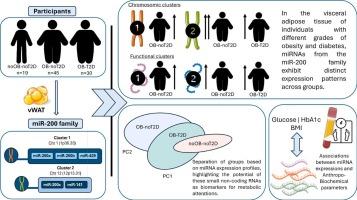The miR-200 family in the context of obesity and type 2 diabetes
IF 7.4
3区 医学
Q1 ENDOCRINOLOGY & METABOLISM
引用次数: 0
Abstract
The miR-200 family is a highly conserved group of five microRNAs (miRNAs) extensively studied in cancer biology. However, its role in metabolic-related diseases remains poorly understood. This study aimed to evaluate the expression patterns of the miR-200 family in visceral white adipose tissue (vWAT) from individuals with different metabolic statuses.
Expression levels of miR-200 family members were analyzed in vWAT samples from 94 participants divided into three groups: normal weight without type 2 diabetes (noOB-noT2D;n = 19), individuals with obesity and without T2D (OB-noT2D;n = 45), and individuals with both obesity and T2D (OB-T2D;n = 30). PCA, correlation analysis, and functional enrichment were performed to explore the biological roles of the miR-200 family in metabolic dysfunction.
Significant differential expression was observed for hsa-miR-200b-3p (p = 0.010), hsa-miR-200c-3p (p = 0.002), and hsa-miR-141-3p (p = 0.004) across groups. Specifically, hsa-miR-200b-3p was upregulated only in the OB-noT2D group compared to noOB-noT2D, whereas hsa-miR-200c-3p and hsa-miR-141-3p were significantly upregulated in both groups of individuals with obesity relative to normal weight individuals. Additionally, positive correlations were found between BMI and the expression of hsa-miR-200c-3p, hsa-miR-141-3p, and hsa-miR-429. Distinct expression patterns emerged when miRNAs were grouped based on chromosomal location or functional classification. Functional enrichment analysis revealed pathways associated with insulin signaling, inflammation, and immune response.
These results highlight the potential of miR-200 family members as biomarkers and therapeutic targets in metabolic disease.

miR-200家族在肥胖和2型糖尿病中的作用
miR-200家族是一组高度保守的五种microrna (mirna),在癌症生物学中被广泛研究。然而,其在代谢相关疾病中的作用仍然知之甚少。本研究旨在评估miR-200家族在不同代谢状态个体的内脏白色脂肪组织(vWAT)中的表达模式。研究人员分析了94名参与者的vWAT样本中miR-200家族成员的表达水平,这些参与者被分为三组:体重正常但没有2型糖尿病(noOB-noT2D, n = 19),肥胖但没有T2D(OB-noT2D, n = 45),肥胖和T2D同时存在(OB-T2D, n = 30)。通过PCA、相关分析和功能富集来探讨miR-200家族在代谢功能障碍中的生物学作用。各组间hsa-miR-200b-3p(p = 0.010)、hsa-miR-200c-3p(p = 0.002)和hsa-miR-141-3p(p = 0.004)的表达差异显著。具体而言,与noOB-noT2D相比,hsa-miR-200b-3p仅在OB-noT2D组中上调,而hsa-miR-200c-3p和hsa-miR-141-3p在两组肥胖个体中相对于正常体重个体均显著上调。此外,BMI与hsa-miR-200c-3p、hsa-miR-141-3p和hsa-miR-429的表达呈正相关。当基于染色体定位或功能分类对mirna进行分组时,出现了不同的表达模式。功能富集分析揭示了与胰岛素信号、炎症和免疫反应相关的途径。这些结果突出了miR-200家族成员作为代谢性疾病的生物标志物和治疗靶点的潜力。
本文章由计算机程序翻译,如有差异,请以英文原文为准。
求助全文
约1分钟内获得全文
求助全文
来源期刊

Diabetes research and clinical practice
医学-内分泌学与代谢
CiteScore
10.30
自引率
3.90%
发文量
862
审稿时长
32 days
期刊介绍:
Diabetes Research and Clinical Practice is an international journal for health-care providers and clinically oriented researchers that publishes high-quality original research articles and expert reviews in diabetes and related areas. The role of the journal is to provide a venue for dissemination of knowledge and discussion of topics related to diabetes clinical research and patient care. Topics of focus include translational science, genetics, immunology, nutrition, psychosocial research, epidemiology, prevention, socio-economic research, complications, new treatments, technologies and therapy.
 求助内容:
求助内容: 应助结果提醒方式:
应助结果提醒方式:


